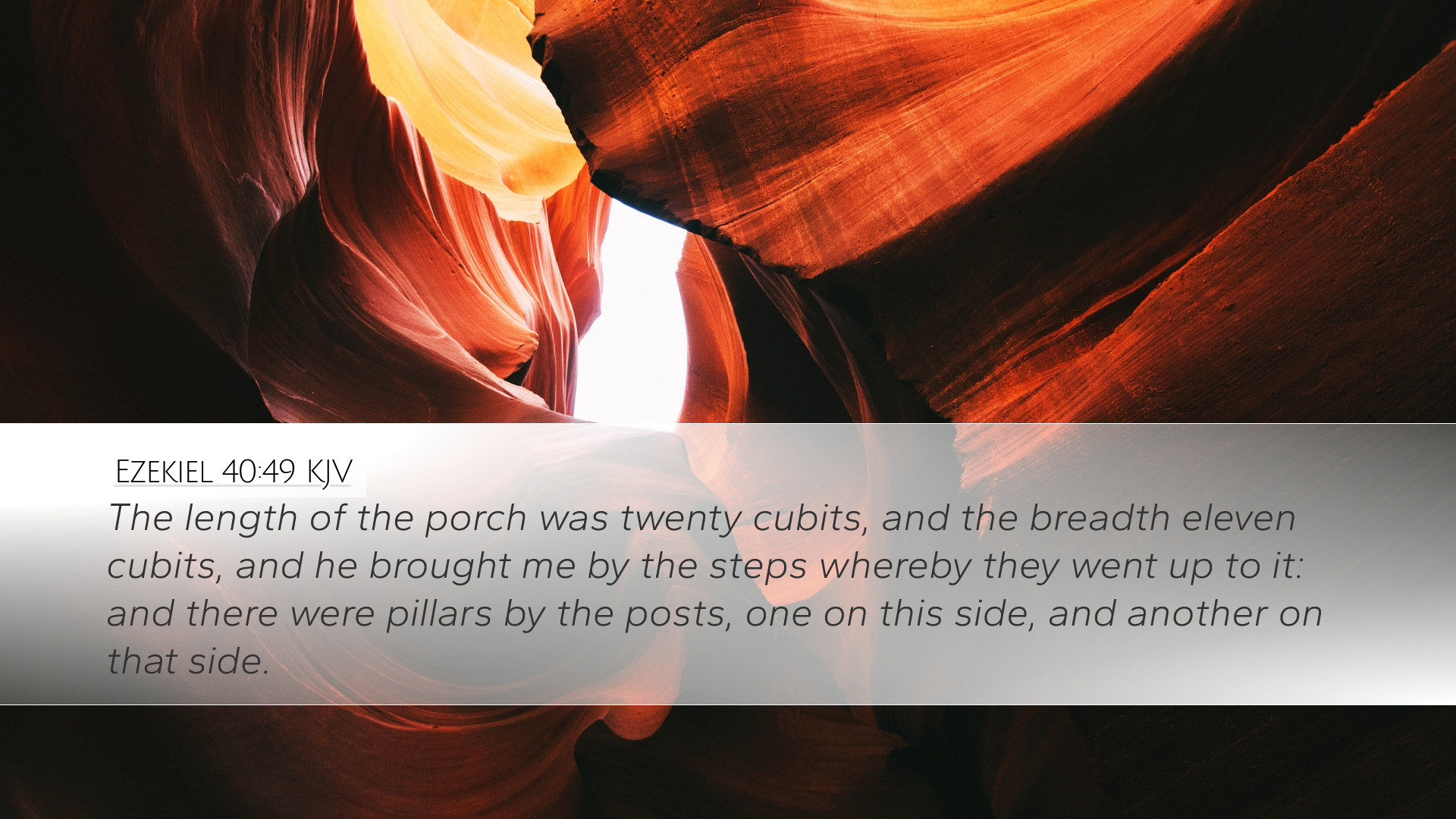Commentary on Ezekiel 40:49
Bible Verse: Ezekiel 40:49 - "The length of the porch was twenty cubits, and the breadth eleven cubits, and he brought me by the steps whereby they went up to it: and there were pillars by the posts, one on this side, and another on that side." (KJV)
Introduction
The vision of a new temple presented to the prophet Ezekiel is one of the most detailed and significant prophetic revelations in the Scriptures. Ezekiel 40 describes the measurement of the temple, emphasizing its grandeur and divine purpose. In this passage, we specifically note the porch of the temple, a place of entry that signifies access to the divine presence. Here, we explore various insights from public domain commentaries to draw deeper meanings from this intricate verse.
Verse Structure and Its Implications
In Ezekiel 40:49, the description of the porch's dimensions serves more than just informational purposes; it is emblematic of the overall vision of God's dwelling among His people.
- Measurement: The specific dimensions of the porch indicate precision in God's plan, a recurrent theme throughout Ezekiel's vision, highlighting God's desire for order and purpose in worship.
- Significance of Numbers: The length and breadth here symbolize completeness and perfection, with 'twenty' often associated with expectation and 'eleven' representing the authority of God.
- Symbolism of Entrance: The porch serves as an entrance, signifying access to God. It is a threshold from the secular to the sacred, reminding believers of the power of entering into God’s presence.
Commentary Insights
Matthew Henry's Commentary
Matthew Henry notes that the porch’s design and its measurement reveal God's infinite wisdom in construction and worship. The porch serves to connect the outer court to the inner sanctum, symbolizing the approach of God's people to communion with Him. The attention to detail reflects God's holiness and the seriousness of worship. Henry emphasizes that the physical structure of the temple illustrates a spiritual truth: that the worship of God must be approached with reverence and care.
Albert Barnes' Notes
Albert Barnes elaborates that Ezekiel's vision serves to reassure the people of Israel of God's continued presence despite their exiles. He underscores that the precise measurements serve to establish that God's covenant relationship is intact and that He has plans for restoration. Barnes points out that the porch was a place of waiting and preparation, indicating that worshipers must prepare themselves to meet God. The pillars signify strength and stability, signifying that God is a stronghold for His people.
Adam Clarke's Commentary
Adam Clarke provides a thorough examination of the symbolism inherent in the porch’s description. He mentions that the measurements and the two pillars represent dual aspects of God’s character: His righteousness and justice (symbolized by the pillars), which must be recognized by those venturing into His presence. Clarke also highlights the architectural style, suggesting that the porch reflects the glory of the kingdom of heaven and invites believers to reflect on their own spiritual journey before God.
Theological Reflections
The insights from these commentaries reveal the layered meaning of Ezekiel 40:49. The descriptions prompt several theological reflections:
- The Presence of God: The temple and its porch symbolize God's desire to dwell among His people. This invites believers to ponder the significance of access to God through Christ, who embodies the new and living way.
- Holiness in Worship: The meticulous nature of the measurements calls for holiness and reverence in worship. It reflects a God who is not indifferent but intricately involved in the lives of His people.
- Restoration and Hope: Given Ezekiel's context of exile, this vision of the temple invokes hope. It reassures Israelites of God's future plans for their restoration, inviting modern readers to grasp the hope found in God's promises amid difficulties.
Practical Applications
For pastors, students, and theologians, the reflections and details surrounding Ezekiel 40:49 lead to practical applications:
- Pursue Holiness: Emphasizing the need for personal and corporate holiness within worship settings can help communities develop a deeper understanding of God's character and their relationship with Him.
- God-Centric Worship: Engaging congregations in worship that centers on God's nature and attributes can enhance their spiritual experience and deepen their relationship with the divine.
- Training in Spiritual Disciplines: Encouraging practices that prepare individuals for encountering God can galvanize their faith and draw them into a more profound worship experience.
Conclusion
Ezekiel 40:49 serves as a vivid reminder of God's deliberate design in both worship and the dwelling of His presence. Through the insights gleaned from esteemed commentaries, one can appreciate the theological richness of this verse and its implications for both the ancient Israelite context and contemporary faith communities. As we meditate on this passage, may we be ever more moved to seek the sacred access granted through Christ, drawing ever nearer to the Lord who desires fellowship with us.


